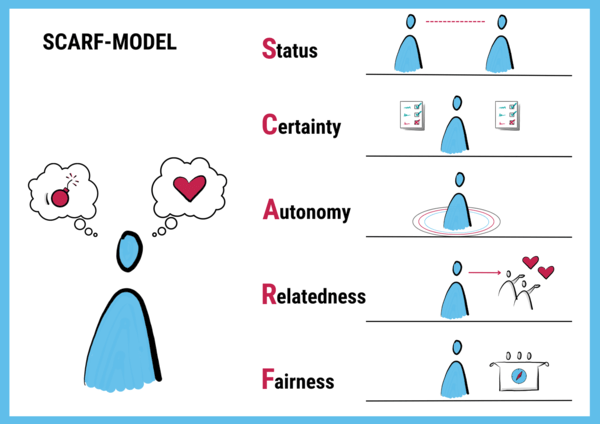Created by Susanne Stock
#favouritemodel No. 32 – SCARF – Psychological safety

We all know our physiological needs. We need to eat and drink enough every day, we need a certain room or outside temperature to avoid freezing or overheating, we need air to breathe, we need sleep to regenerate our bodies. But what about our basic psychological needs?
Modern neuropsychological research provides us with important insights into what a person needs in order to remain not only physically but also mentally healthy. David Rock, co-founder of the Neuroleadership Institute, has developed the so-called SCARF model. In this model, he describes 5 factors that influence our behavior. SCARF is an acronym consisting of the first letters of these individual dimensions: Status – Certainty – Autonomy – Relatedness – Fairness.
The model is based on the insight that human behaviour is based on fundamental biochemical processes and that our brain strives to maximize rewards and minimize threats. When we experience a threatening interaction in a professional/social context, our brain releases the stress hormones cortisol and adrenaline. This triggers the same stress mechanisms that we experience when we are in physical pain or under acute threat (for example, from the much-mentioned tiger standing in front of us). Conversely, our body reacts to social situations that we find pleasant by releasing dopamine, serotonin, endorphin or oxytocin, which makes us feel good and full of energy.
From an organizational perspective, this is an exciting insight, as it helps managers and teams to recognize the various basic needs of employees and create a culture in which threats are minimized and rewards are maximized. This increases the chance that employees will be able to draw on their positive resources and work with the team to find ways of dealing with stressful situations.
When managers and teammates act according to the SCARF model and adapt their actions to the needs of each person, this leads to a trusting environment in which employees can perform.

STATUS
Status” is about the relative position of the players in relation to each other and the influence that their personally perceived positioning has on their individual well-being and behavior. Status is reflected in the fact that employees feel that they are recognized and important to their team and the company.
The need for status is influenced by various contextual conditions, e.g:
- I receive positive feedback on my work from my superiors and colleagues.
- I hold a recognized position in the company in which I am acknowledged as an expert/manager.
- Other colleagues ask me for advice.
- I am involved in important decisions and have access to certain management levels/decision-makers.
- External status symbols such as a company car, bonuses and gym memberships also have an influence. However, as these are extrinsic motivators, their influence on the reward system is less sustainable than the influence of the preceding social/interactive influencing factors.
The need for status is threatened by the following conditions, for example:
- There is a negative error culture in my team, in which failures, mishaps and mistakes are punished without looking to the future for solutions. In such a case, it is likely that feedback discussions with my line manager or colleagues, for example, are perceived as threatening and I tend not to initiate them proactively.
- In stressful situations, everyone is preoccupied with themselves. Stressors and personal emotions are not addressed. In such a case, I would rather try to keep my fears and frustrations to myself. Disclosing my emotions could lead to a drop in my reputation/status with others if I show “weakness”.
In order to strengthen the need for status and thus also the resilience of their employees, managers should be able to classify this employee behavior and reflect on how they can change the framework. Employees need the space and openness to talk about current stressful situations without being judged, to recognize that they are not alone in the situation and that they can support each other as a team. Regular, solution-oriented and positive feedback continuously increases employees’ self-esteem.
CERTAINTY (SECURITY)
Certainty is based on the need to be able to predict the next steps to some extent and thus maintain a feeling of control and security over one’s life. Major changes often lead to this need being thrown out of balance.
The need for security is promoted by:
- Clear processes and agreements that the team adheres to.
- I can trust that communication will be honest and that promises will be kept (walk the talk).
- Uncertainties are discussed and addressed promptly.
- I trust my team and the management to deal with difficult situations constructively.
The need for security is threatened, for example, by:
- Unclear goals in the team. Everyone works according to their own (hidden) agenda.
- I am left in the dark for weeks, maybe even months, when it comes to change processes. There is no process in the team to discuss or address these uncertainties.
- I can’t rely on the things that are communicated by management or colleagues.
Studies show that a constant threat to our need for security can even have a negative impact on our working memory and reduce our ability to concentrate. It is therefore important to create a framework within the team in which continuous transparency about the goals of the project is established and mutual expectations are clarified. In change processes, it is helpful to repeatedly initiate review meetings that help employees to see which steps/milestones have already been achieved and which sub-goals still need to be reached. This makes the change manageable and creates a sense of control.
AUTONOMY
Autonomy is about my degree of freedom and the opportunity to help shape and determine my own life. Like all needs, this is also very individual.
The following conditions are conducive to the need for autonomy in the work context:
- I can decide freely about my area of work.
- I can freely choose my working methods according to my preferences. Do I want to work from home, in the office or hybrid? Can I organize my working hours freely? Can I choose work tools (software, hardware, tools, etc.) according to my preferences?
- I can work according to my talents and abilities.
- I have the opportunity to express my perspective. My ideas have an influence on the decisions that are made.
The following conditions, for example, pose a threat to the need for autonomy:
- My working environment and work processes are strictly regulated. Everything has to be implemented according to work instructions; there are no opportunities for me to contribute my own (improvement) ideas or personal routines.
- My perspective is not caught up with or ignored.
- Suggestions for improvement are not implemented.
In order to give employees a sense of autonomy, the first step is to delegate tasks to them in full. They should have room for maneuver and be given responsibility for the specific way in which the task is carried out. Micro-management and constant intervention in work processes can have a very demotivating effect on employees.
In change processes, managers should ensure that team members can help shape the change from the outset and thus make the change their own. If a team can help shape its own future, this has a very positive effect on the feeling of autonomy and self-efficacy. This strengthens the team spirit, the team’s energy levels and, in the long term, its resilience in dealing with any uncertainties that may arise.
RELATEDNESS (SOCIAL RELATIONSHIPS)
The need for connection describes the feeling of belonging to a group and feeling comfortable with colleagues. When trust develops in a team, issues can be discussed more openly and performance and solution orientation increase. A positive team atmosphere provides individual protection and at the same time leads to team members trying to protect their group. The messenger substance oxytocin is released, which strengthens the bond within the group. However, if a team member feels excluded, the same areas of the brain are activated that are otherwise activated when physical pain occurs. The feeling of loneliness arises.
The need for connectedness can be ensured by:
- The promotion of interpersonal contact. It is allowed and practiced to talk about challenges as well as things that have brought fun and joy to the project.
- The team also exchanges ideas outside of official meetings, during (virtual) coffee breaks, in one-to-one conversations or at team events that are organized together.
- The team lives a culture of active listening. People let themselves be heard and make sure that all team members are given enough space to open up and that speaking time in meetings is roughly equally distributed.
The need for connection is violated when:
- There is no regular exchange within the team.
- In discussion rounds, not all perspectives are heard, but only the same people present their thoughts. The lack of moderation and involvement of the quieter team members means that they lose contact with the team.
- There is a team culture in which people talk about others rather than with others.
- The manager is hardly available (virtually). There are no regular one-to-one meetings with the team members, so no real bond can develop between the manager and team members.
Managers should promote a culture of togetherness in which projects are not dealt with by each individual in a “quiet chamber”, but in which there is transparency about where there are meaningful overlaps / opportunities for collaboration. The exchange of ideas during coffee breaks or team events should be encouraged so that the group develops a sense of solidarity. At the same time, the manager should keep an eye on what the various bonding needs in the team look like. There are differences here too and not everyone feels comfortable revealing a lot of private information. It is important to value this diversity in the team and not to devalue it, so that each team member can open up as much or as little as they need to.
FAIRNESS
This dimension is about the question of how fairly I feel I am treated in comparison to others. People have fine antennae for fair or unfair behavior, observe their working environment closely and (unconsciously) make constant comparisons with themselves and their fellow human beings.
The need for fairness can be met by:
- The team discusses the various needs and draws up its own rules for working together based on these.
- Information is handled transparently.
- Unpleasant tasks are distributed fairly within the team.
- Overtime or special services are fairly remunerated.
The need for fairness is threatened by behaviors such as:
- Decisions seem arbitrary or are not sufficiently justified.
- The same team members are always brought in for the exciting new projects.
- A colleague repeatedly struggles to complete their tasks, which requires support from the team. What initially starts out as collegial assistance can be perceived as unfair by colleagues after a while, as they regularly have to work longer and harder.
In order to promote a fair team culture, it is important that the entire team is transparent with information. In this way, situations that are perceived as unfair can be addressed and resolved openly. If employees feel unfairly treated and this situation festers for a long time, this can have a major effect on motivation and resilience in the team and also have a negative impact on the other SCARF dimensions, especially relatedness and status.
The SCARF model offers many opportunities to reflect on your own needs as a first step and then to better understand the needs of your team colleagues. Introduce the SCARF model to your team and talk about how everyone assesses the SCARF dimensions for themselves. You can then look together for ways to reduce the threats of the SCARF dimensions for your team and maximize the rewards. Good luck with that!
Author

Susanne Stock
Project partner




